Blackheads
Blackheads – also known as open comedones – show up on the skin as dark spots in the pores of the sebaceous glands. For much of the twentieth century, beauty experts described them as a build up of dirt and sebum caused by a lack of cleanliness.
A “blackhead” is a pore which is full of grease and dirt that have grown hard from longstanding. Most women who suffer mortification from blackheads would be highly indignant if anyone told them that it is because they don’t keep their faces clean; yet it is the simple truth.
(Anstruther, 1912, p. 25)
An early variation on this theme was that blackheads were associated with parasites, namely the face mite Demodex folliculorum.
Blackheads are a form of acne indicated by little black specks on the skin, chiefly about the nose, forehead and chin. … The black speck, giving this little cylinder of fat the appearance of a head is, shocking as it is, simply an accumulation of dirt. The technical term for one of these little masses is comedo. When examined under a microscope, they are frequently found to contain a whole family of parasites—male female and their progeny.
(Ayer, 1899, pp. 137-138)
By 1915, any relationship between Demodex and blackheads had been discounted but the belief that blackheads were caused by dirt persisted. This is puzzling as the German dermatologist Paul Gerson Unna [1850-1929] found that the black was due to melanin not dirt back in 1880.
[Unna] found that the black head existed in comedones that were so deeply seated in the skin that the overlying layers of epithelium rendered these invisible, so that he was compelled to suppose that if dirt were the real cause of this coloration, it must have got there while the follicles were open, and then the epidermis have grown over the opening of the follicle. But he finds that this is not the case, and argues, that if dirt were the cause, black-headed comedones should be found with greatest frequency in coal miners and others engaged in dusty occupations, and also more frequently in the face than in other parts of the body. This is not the case, however. The crucial test was now applied by Unna, of examining the substance microscopically, and no dirt or indications of dirt were found.
(“What constitutes the black head of the comedone,” 1880, p. 538)
The idea that the black in blackheads was dirt may have persisited because it was useful to soap and cosmetic companies. It gave them a platform from which to sell soap and skin cleansers.
Salon treatments
Treatments for blackheads were included in many beauty salons. In most cases this involved extractions. If the problem was minor it would be included in a general facial treatment but if it was more severe it would become part of an astringent treatment or be included in a facial designed to reduce enlarged pores. All these treatments began with cleansing to remove dirt, sebum and grime and finished with an astringent to ‘close the pores’.
See also: Skin Tonics, Astringents and Toners and Enlarged Pores
Extractions
Although some beauty writers advised against it altogether, if the ‘dirt’ in the blackhead could not be removed by cleansing, then pressure could be applied to the skin to ease the blackhead out. Given that the skin might be bruised during this treatment many beauty experts recommended using a comedone extractor or a watch-key instead of the fingers.
If, after the face is washed, the little black points still remain, take a soft linen cloth or the end of an old towel and with equal parts of cologne and water or of alcohol and water rub them out.
If they are too large to yield to such treatment, then they can be removed by a watch-key or a comedone extractor, which is very like a watch-key. It should be placed carefully, so that the comedone comes in the centre of the aperture and then firm and gentle pressure should be made, until the little worm-like contents of the sebaceous follicles are expressed. One should avoid irritating the skin too much; if there are very many blackheads and they are close together, it is better to wait a day before repeating the process.(Murray, 1904, pp. 36-37)
In addition, as bacteria were generally considered to be associated with dirt, extractions were often proceeded by, or followed with, a disinfectant.
Steaming
Beauty writers often suggested streaming the face before conducting extractions, to open the pores and soften the plug. Those that disagreed with this practice generally did so because they thought that steaming relaxed the skin, causing it to stretch – the opposite effect to that produced by an astringent – which led to enlarged pores and wrinkles; or that it robbed the skin of oils leading to premature ageing.
Some women make the sad mistake of trying to steam the face to soften blackheads. Never do this; you will destroy the natural oils of the skin and cause it to dry out and wither long before its time. Instead, when washing the face at night apply hot cloths to it, renewing constantly by wringing freshly out of very hot water every half minute or so, as they cool.
(Rion, 1913, p. 26)
See also: Vaporisers (Steamers & Atomisers)
Electrolytic Cup
This early American machine combined vacuum suction with a galvanic current that produced an alkali (sodium hydroxide). Together these helped cleanse the skin, open pores and extract impurities including blackheads.
See also: Galvanic Treatments and Electrolytic Cup
Desincrustation
In the 1930s a galvanic treatment known as desincrustation was introduced to help remove skin-clogging ‘incrustations’. Like the electrolytic cup the process also produced an alkali (sodium hydroxide) resulting in a mild exfoliation that was believed to make extractions easier.
See also: Desincrustation
Home treatments
Blackheads could also be treated at home. The description below, from 1937, uses steam to open the pores, soap to cleanse the skin, fingers to extract blackheads and lemon juice or alcohol to act as an astringent/disinfectant. Prominent blackheads on the face were generally treated but places where they were out of sight, such as in or behind the ears, were often missed.
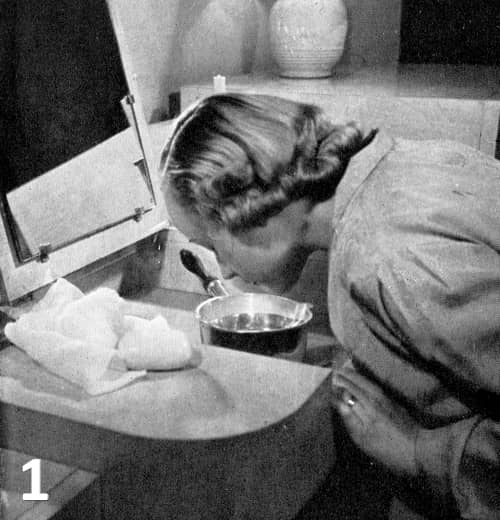
1. Steam with hot water vapour to make the skin softer.
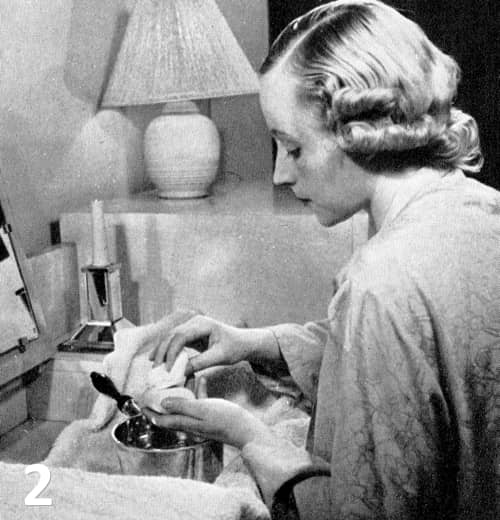
2. Create a large soapy pad using very soft soap.

3. Rub the blackheads with the pad turning it over to get a fresh surface.
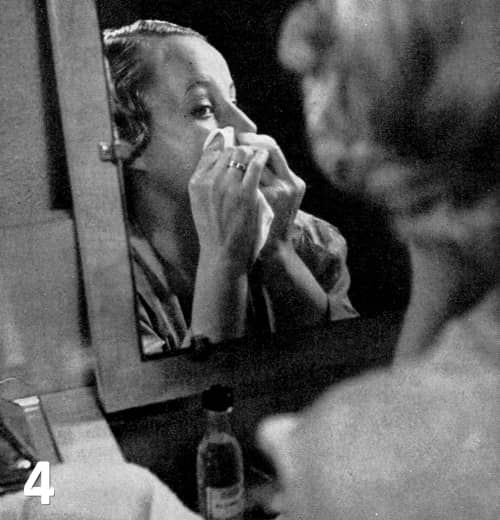
4. Extract the comedones with the fingers covered in tissues.
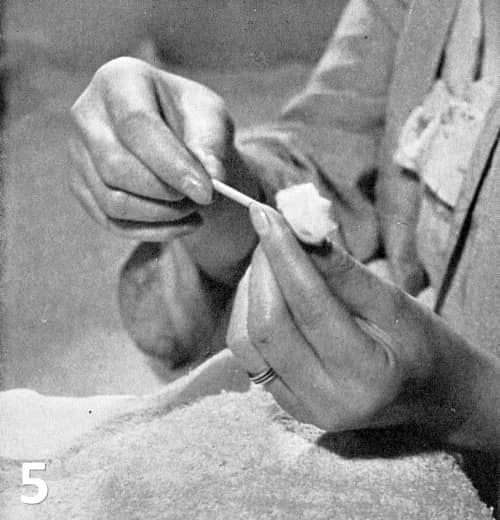
5. Wrap the end of a thin orange stick in cotton wool.
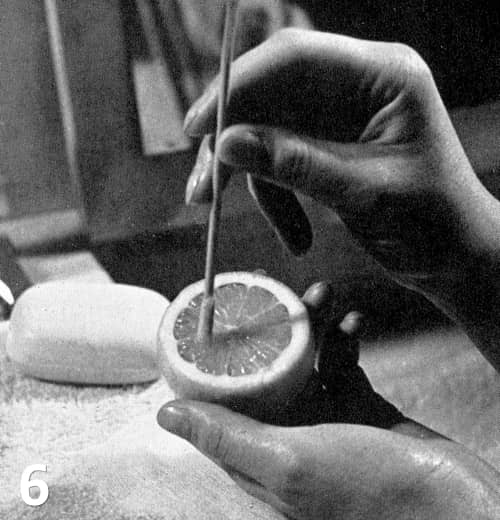
6. If the skin is dry, soak the wrapped orange stick in lemon juice.
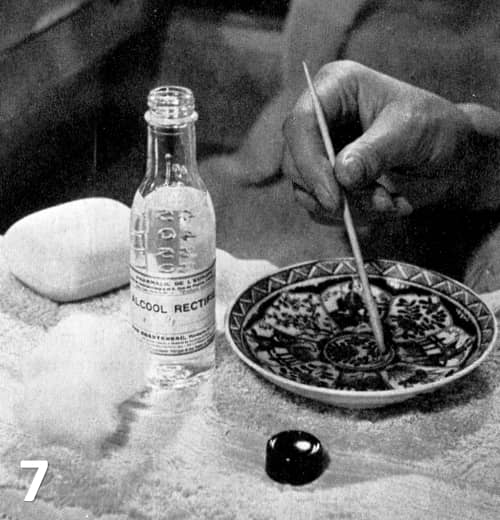
7. If the skin is greasy, use alcohol heated to 32°C (90°F).
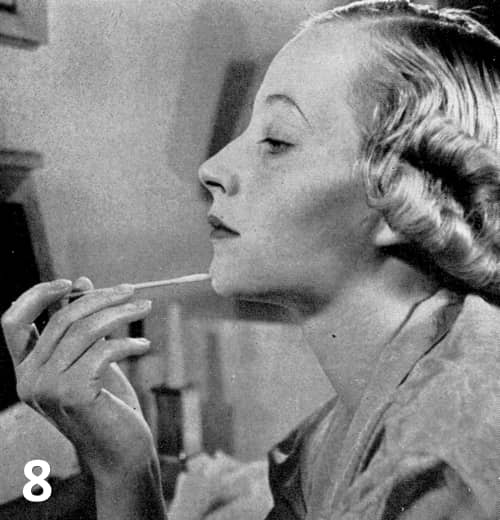
8. Dab each empty pore with the lemon juice or alcohol but change the cotton wool each time.
Mercury bleach creams
Ammoniated mercury bleach creams are banned in most countries today but were commonly used in the past. Some ammoniated mercury bleach creams claimed to reduce blackheads. Rather than bleaching the melanin in the blackhead the action came through the skin exfoliation produced by the hydrochloric acid released when the mercury salts reacted with the skin. This would ‘loosen the pores’ and make extractions easier.
See also: Mercolized Wax
Medicated skin-care
After the Second World War the cosmetic industry became increasingly interested in the youth market. The pharmaceutical branches of cosmetic companies developed a number of medicated skin-care and make-up lines containing antibacterials specifically for this market.
See also: Hexachlorophene
Cleansing was an important selling point for the assorted soaps, scrubs and other cleansers produced by the cosmetics industry for the youth market. As blackheads were still considered by many people to be caused by dirt, these medicated products often claimed to be effective against them as well.
Updated: 1st August 2018
Sources
Anstruther, E. (1912). The complete beauty book. New York: D. Appleton and Company.
Ayer, H. H. (1889). Harriet Hubbard Ayer’s Book. A complete and authentic treatise on the laws of health and beauty. Including many carefully tested formulas hitherto unpublished. Good health how to preserve it. Good looks how to obtain them. With full instructions for physical culture, facial, scalp and general massage. New York: Home Topics Book Company.
Blair, C & Lewis, C. A. (1970). The pigment of comedones. British Journal of Dermatology, 82, 572-583.
Chrysis. (1928). Clipping beauty’s wings: Blackheads. Eve Magazine.
Rion, R. (1913). The beauty book. Holyoke, MA: The Elizabeth Towne Company.
Uhoda, E., Piérard-Franchimont, C., Ludivine Petit, L., & Piérard, G. E. (2005). The conundrum of skin pores in dermocosmetology. Dermatology, 210, 3-7.
Unna, P. G. (1880). Ueber den schwarzen punkt bei den comedonen. Virehow’s Archive. 82(1), 175.
What constitutes the black head of the comedone. (1880). Chicago Medical Review. 2(11), 538.
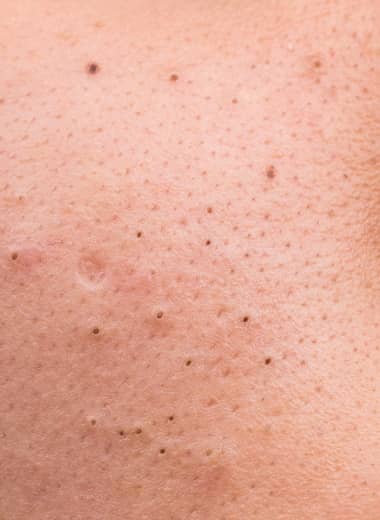
Blackheads. In the past they were sometimes referred to as ‘flesh worms’. Unna’s finding (1880) that the dark spots were caused by melanin was supported by Blair and Lewis in 1970 when they reported that albinos do not get blackheads (Blair & Lewis, 1970).

Demodex mites, either Demodex folliculorum or Demodex brevis, are part of the normal skin fauna. Everyone has them to some degree.

c.1910 Electrical treatment for blackheads.
When blackheads were believed to be associated with Demodex mites electrical treatments were suggested as a medical procedure.
Using a direct electrical current supplied by a battery, a negative electrode was rubbed over the forehead, chin and nose or wherever blackheads were present until the skin took on pink tinge bordering on red. Initially salt water or a weak solution of sodium carbonate was the recommended medium but after a few days of treatment this could be replaced with a weak disinfectant (Blanc, 1910).
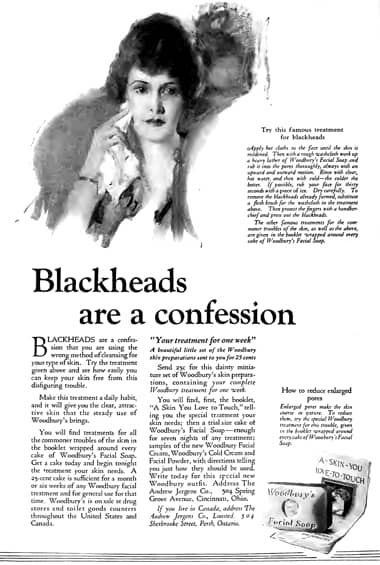
1921 Woodbury Facial Soap.
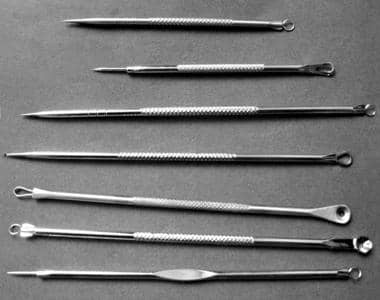
Assorted comedone extractors. They are also made as part of a set of tweezers.

1925 Ingram’s Milkweed Cream.
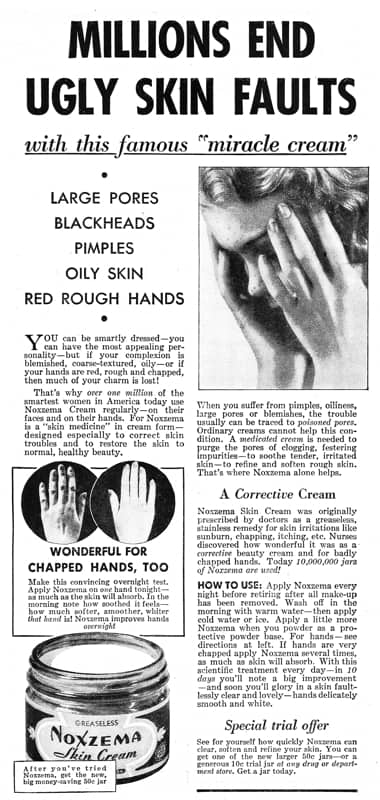
1934 Noxzema Skin Cream containing camphor, menthol, olive oil and eucalyptus oil.
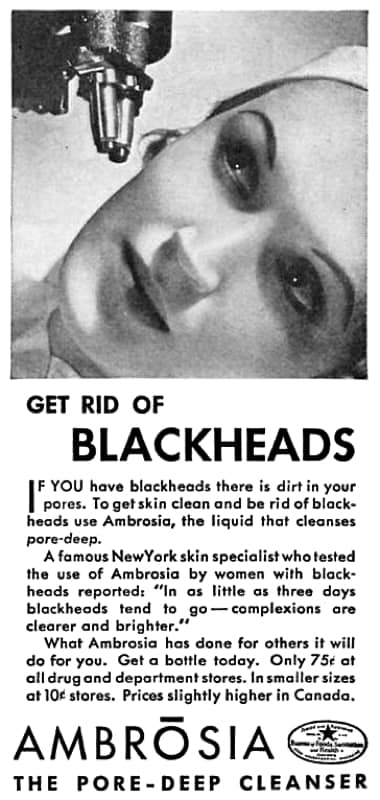
1935 Ambrosia.
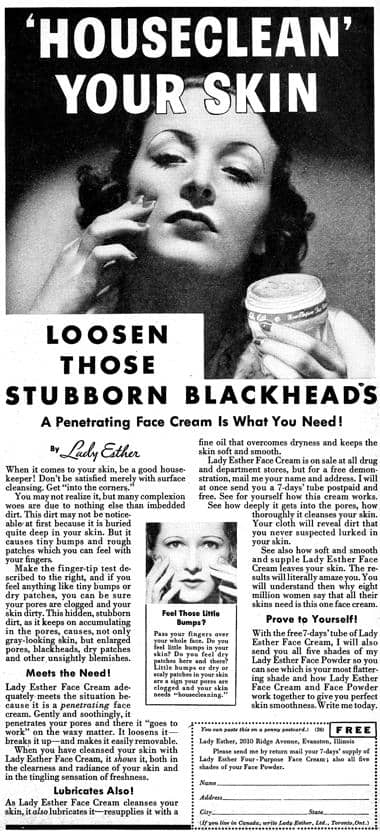
1936 Lady Esther Face Cream.
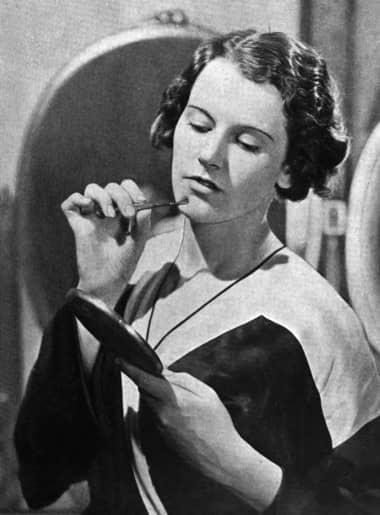
1937 Removing a blackhead using a comedone extractor.
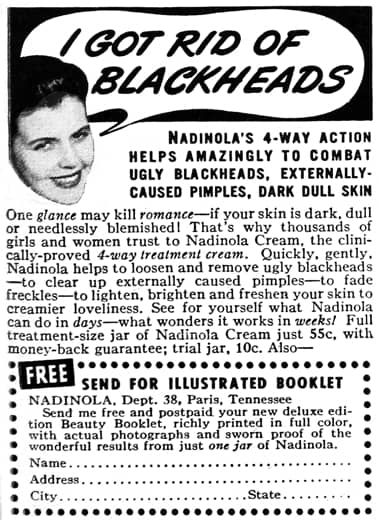
1946 Nadoline Cream. The product contained ammoniated mercury which acted as a bleach and an exfoliant.
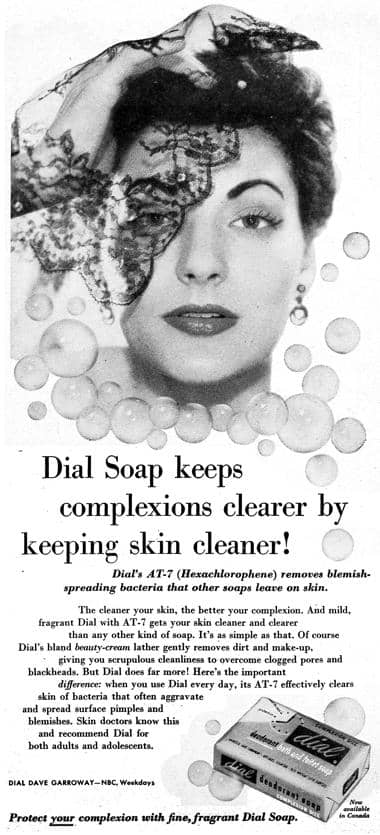
1953 Dial Soap with hexachlorophene. The success of this product resulted in the widespread use of hexachlorophene in skin-care lines and make-up until the product was banned in the 1970s.
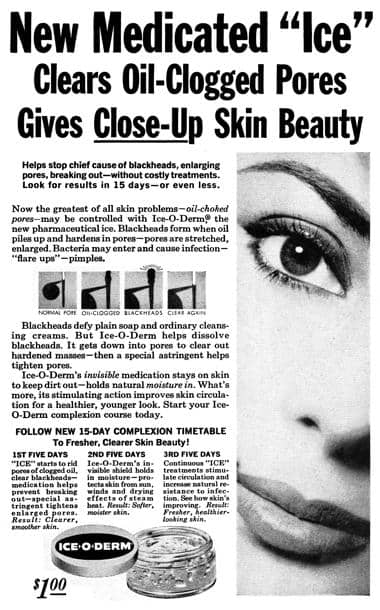
1962 Shulton Ice-O-Derm containing the antibacterial parachlorophenyl-alpha-glycerol ether for pimples and blackheads. The product claimed to ‘dissolve blackheads’ and ‘tighten pores’.
